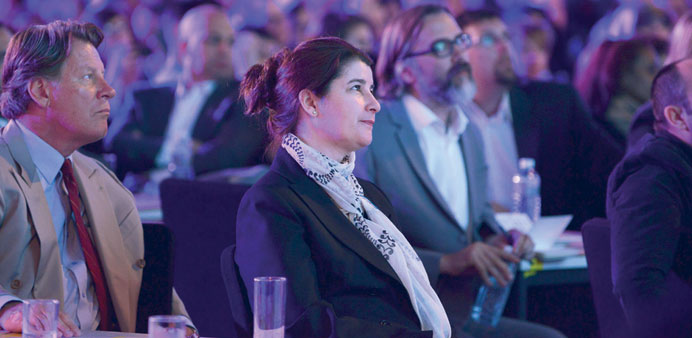By Joseph Varghese/Staff Reporter
Acclaimed Dutch architect Rem Koolhaas delivered the keynote address at the concluding ceremony of Tasmeem Doha 2013, which was held at the Students’ Centre
of Hamad bin Khalifa University (HBKU) in Education City on Sunday.
The biennial design conference was organised by Virginia Commonwealth University in Qatar (VCUQ) in partnership with Qatar Foundation (QF) and Mathaf: Arab Museum of Modern Art.
HE Sheikha Mayassa bint Hamad bin Khalifa al-Thani, Chairperson of Qatar Museums Authority (QMA) and Susan L Ziadeh, US Ambassador to Qatar, were among the distinguished guests who were present at the event.
A major component of the conference was the exploration of the role played by art and design in the transformation of Qatar from a small pearl fishing community to a pre-eminent centre for the arts and a popular tourism destination.
Speaking on various architectural designs that he has developed around the world, Koolhaas highlighted the specifications of some of the buildings. “In Qatar, we have designed three projects. These include two buildings in Qatar Foundation alone. We are building the headquarters of Qatar Foundation as well as Qatar National Library in the same compound,” he said.
Giving the designs of these buildings, he elaborated on the specifications of each of them and how they would suit the purpose of each structure. The headquarters of QF has a box shape while the national library building with its singular design will help users feel relaxed, creating a perfect atmosphere for studying and learning. The third project designed by him is the upcoming Airport City near the new international airport.
Koolhaas spoke about his work as a writer, creating OMA (Office for Metropolitan Architecture) and its thinktank, AMO, as well as his various projects, including the headquarters of China Central Television and his project with Prada, among many others.
On the QF headquarters, he said OMA looked at the various shapes in Education City to design the tower and make it “superior and serene”. “It doesn’t show you what’s going on inside, but the interior design intricacies show it’s not as serene as the outside,” adding that the building is “not dominant but at the same time, makes it almost charming in its intensity”.
VCUQ dean Allyson Vanstone said the conference has been highly successful for various reasons. “VCUQ has been able to forge close ties with the local and international community and this is replicated through many of the outcomes of the conference. Unlike traditional conferences, much of this year’s Tasmeem Doha was structured as a series of ongoing activities, collaborative workshops and exhibitions,” she asserted.
Vanstone said there were plans to publish a Tasmeem Design Journal with selected papers from the 2013 conference. “By deliberately embracing new territories within the conference format, we expanded the framework and scope to create an opportunity for experimentation and research,” she added.
Tasmeem Doha had a number of projects completed by the students and faculty of VCUQ. Mathaf hosted the 13 designer-led student laboratories, which were full-scale explorations done through the very act of making. The outcomes of the laboratories would be on display until the end of this month.
Similarly, the Tasmeem Hybrid-Making workshops which took place at VCUQ were interdisciplinary, collaborative sessions that were designed to produce viable end products. Many of the works of the faculty as well as a special project named “Made in Qatar” are on display at the Students’ Centre.

VCUQ dean Allyson Vanstone among the audience.
